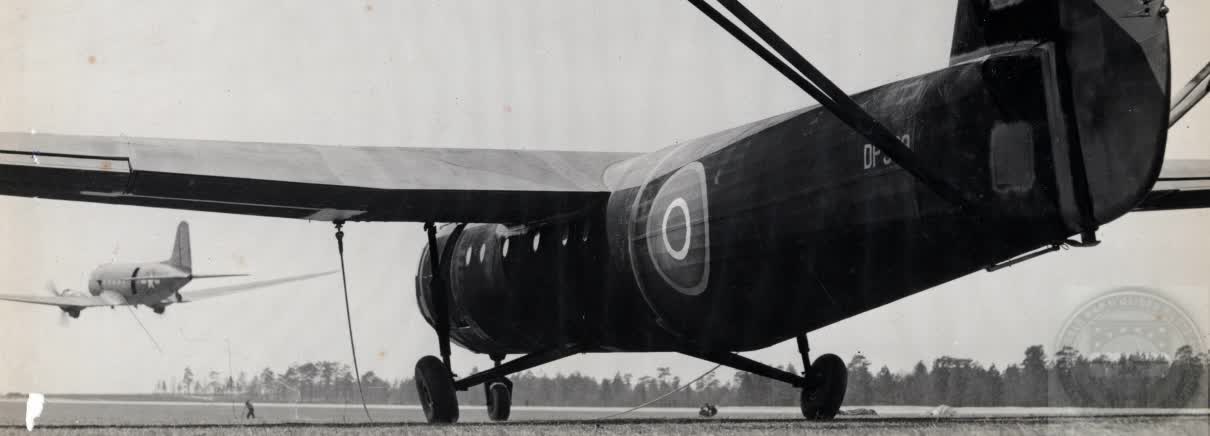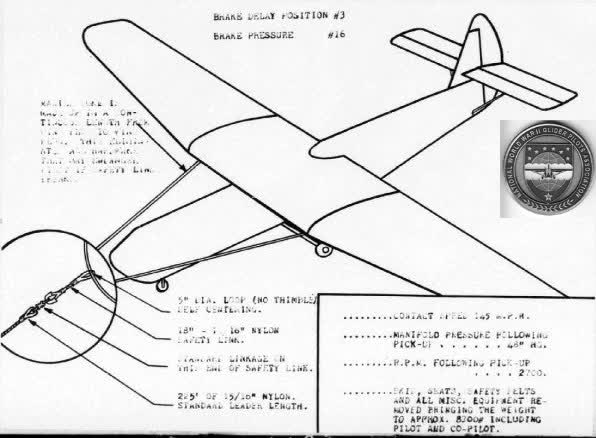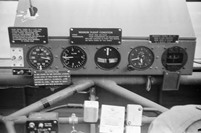H E A D Q U A R T E R S
38TH TROOP CARRIER SQUARDON AAF
LAURINBURG-MAXTON ARMY AIR BASE
Maxton, North Carolina
1 April, 1944
HISTORICAL REPORT FOR MONTHS OF FEBRUARY & MARCH 1944
ENGLISH GLIDER SNATCH FROM GROUND BY C-47: This caption would have appeared in daily newspapers had reporters been present at the colossal event. For the first time in the history of the world, and English Horsa Glider was picked up from the ground by a C-47.
The first Horsa was sent to us from the Philadelphia Navy Yard sometime back in October 1943, when the 38th Troop Carrier Squadron was stationed at Camp Mackall, North Carolina. Lt Col. Mike Murphy was the first member to fly the English Glider. He, in turn, taught 2nd Lt. Julian R. Hall, who continued in the capacity of Horsa Instructor.
Since that period in October, 2nd Lt. J. R. Hall has checked out approximately 30 men as first pilots. Hundreds of students have been given familiarization rides, and a ride in a Horsa is now considered part of the GP’s curriculum.
When interviewed about the Horsa pick-up episode, Lt. Hall exclaimed Smoothest pick-up I ever flew. For a half hour, Lt. Hall went into raptures about the Horsa and the pick-up system.
The pick-up system was introduced to the 38th Troop Carrier Squadron in November 1943 by 1st Lt. O. J. Decker, who came to us from Wright Field, Ohio.
This system is a method of towing a glider from the ground into full flight condition by a plane which remains in flight during the entire operation. Its advantages over the standard glider take-offs are manifold. Several of the important advatages are as follows:
- Terrain unsuitable for towship operation such as soft, uneven ground and limited areas, still allow glider take-offs via the pick-up method.
- Recovery of the valuable glider following a tactical mission effectively decreases material expenditure.
- Deliver of an airworthiy glider ready to perform again at a substantial saving in time and man hours
The necessary pickup-up equipment constists of the following:
- A C-47 modified with the pick-up unit (an installation weighting approximately 700 pounds)
- Special length nylon ropes and two poles 12’ high to support the nylon rope in the air. This allows the pilot of the pick-up plane to swoop down low over the poles and hook on to the nylon rope with a hook that is supported below the airplane by a 20%rsquo; wooden arm.
The pick-up procedure, itself, is fairly simple. The glider, to be snatched, remains at rest in a position facing into the wind. A rope attached to the glider angles off to the right and extends outward 225 feet. A nylon loop with a circumference of 80 feet supported by tow 12 foot polies approximately 22 feet apart is attached to the end of the 225 foot rope. The plane swoops down on the starboard side of the glider at a speed determined by the weight of [the] glider and condition of [the] ground. A wooden arm guides the rope into the hook and the hook unclips from the arm. The hook is attached to 1050 feet of 3/8’s flexible cable and is wound around the drum in the pick-up unit installed in the C-47. The cable pay-out is resisted by a set of multiple disk brakes which gradually and smoothly accelerates the glider to the speed of the towship. The glider usually ends its acceleration period in seven or eight seconds and 600 to 700 feet behind the plane. The pick-up unit is equipped with a motor to wind in the cable when the occasion requires.
AERIAL PICKUP OF THE HORSA BY A C-47:

DIAGRAM SHOWING ROPE ATTACHMENT FOR TOW OR HORSA:

|















